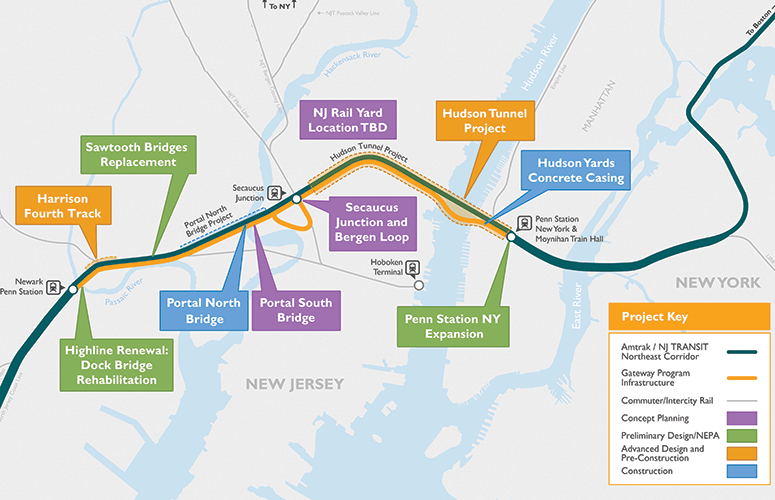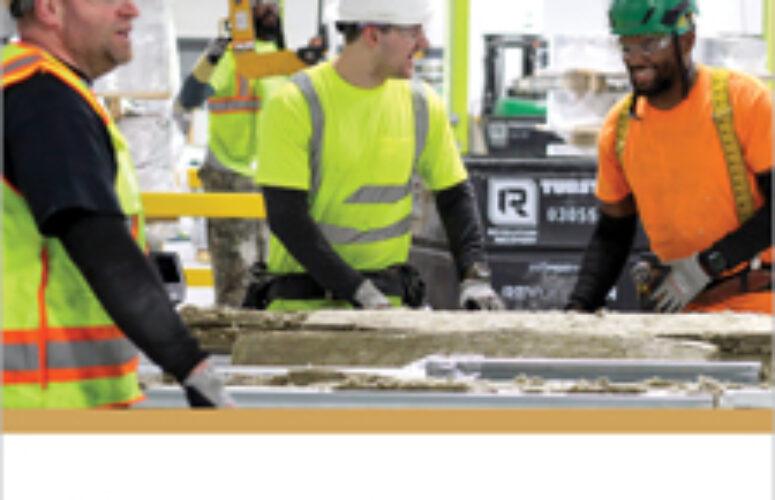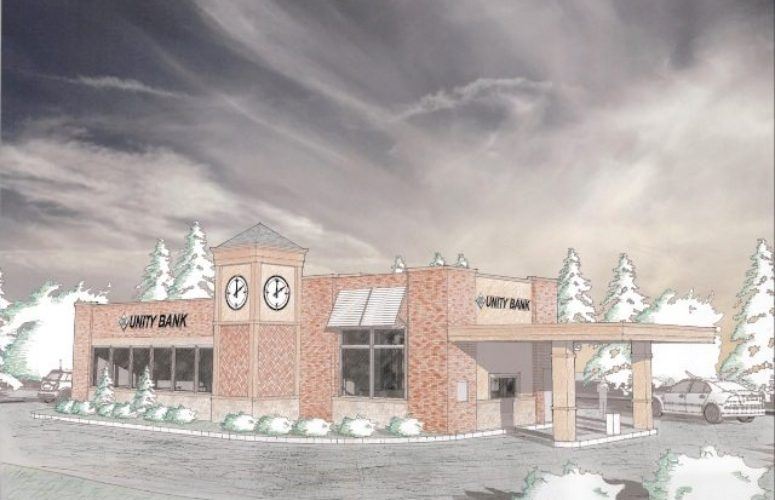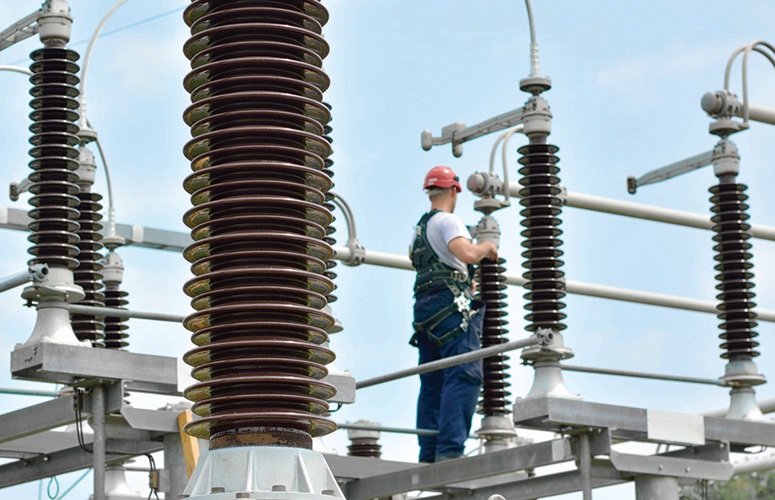
America’s Most Critical Infrastructure Project
The Gateway Program is a once-in-a-generation transformation that is underway for Northeast commuters.
By Jim Pytell, Managing Editor On Mar 4, 2024Often cited as the most urgent infrastructure project in America, the Gateway Program is a series of projects aimed at improving the most congested 10-mile section of the Northeast Corridor, which is the most heavily used passenger rail line in the US, with more than 2,000 trains per day carrying approximately 800,000 daily passenger trips across eight states and Washington, D.C.
The portion of the Northeast Corridor between Newark and New York Penn Station carries more than 200,000 daily Amtrak and NJ TRANSIT passenger trips on approximately 450 trains. It also only has two tracks, while a majority of the remainder of the Northeast Corridor has four.
Gateway will see the rehabilitation of these two 113-year-old rail tunnels under the Hudson River into Manhattan as well as the creation of two new additional tunnels, expanding capacity and alleviating congestion.
According to President Joe Biden, if these current lines shut down for just one day, it would cost the US economy $100 million.
New York Senator Chuck Schumer also states that if the rail artery on the Northeast Corridor ever backed up, “the heart of the national economy would cease to operate. America would go into a recession overnight. Millions of people would lose their jobs and the George Washington Bridge and the Lincoln and Holland tunnels would be jammed 24/7.”
In addition to the new tunnels, Gateway’s other projects include: new tracks and platforms at New York Penn Station, new Portal North and South Bridges over the Hackensack River in New Jersey, construction of loop tracks in Secaucus and replacements for the Sawtooth Bridges, and other needed infrastructure improvements along the corridor.
Portal North Bridge and Hudson Tunnel
Two major aspects of the Gateway Project include the Portal North Bridge and Hudson Tunnel projects, both of which are currently under construction.
Stephen Sigmund, chief of public outreach for the Gateway Development Corporation (GDC), calls these projects linchpins for regional travel, adding that work has been needed on them for 30 years.
“We are relying on something that is 113 years old,” Sigmund says, referring to the Hudson Tunnel in particular. “It has done its job – and still does its job everyday – but it is long past time to modernize the system and make it a 21st century tunnel that is reliable and resilient. [This work is] relieving a critical fracture point on the Northeast Corridor. When either the bridge or the tunnel has a problem, it backs up the entire corridor. The immediate impact of this modernization is that when you take a train that is supposed to take 35 minutes in the morning, it will actually be 35 minutes.”
The deterioration of the tunnels were also made worse by saltwater damage incurred by Superstorm Sandy more than 10 years ago, something that Sigmund says further demonstrated the need for upgrades.
He adds that work on the Hudson Tunnel will create more than 72,000 direct, indirect, and induced jobs, as well as stimulate the economy by generating $19 billion in economic activity over the project’s construction period.
GDC CEO Kris Kolluri calls the Hudson Tunnel project the forefront of a new American renaissance in infrastructure.
Additionally, the Portal Bridge, which carries 450 Amtrak and NJ TRANSIT trains per day, will also see replacement of its outdated and increasingly unreliable structure with a modern, more reliable fixed-span bridge that is much higher over the water, allowing boats to pass underneath without the need to open and close. A new bridge will also permit higher track speeds and increased capacity and save millions of dollars in maintenance costs, according to the GDC.
Grants and Costs
Jason Abrams, senior public relations manager at Amtrak, is optimistic that Gateway and its various components will continue moving forward as planned.
“Construction of the new Portal North Bridge is making significant progress and work kicked off on both sides of the Hudson River late last year for the Hudson Tunnel Project. We are seeing a record level of investments into these projects thanks to funding from the Infrastructure Investment and Jobs Act (IIJA) – the largest investment in passenger rail in the past 50 years,” he says.
In fact, when President Biden announced $16.4 billion for Northeast Corridor projects in November, more than 25% of that funding was awarded to Gateway Program projects including: the Hudson Tunnel Project ($3.79 billion awarded to GDC), the Dock Bridge Rehabilitation Project ($300.18 million), and the Sawtooth Bridges Replacement Project ($133.32 million).
This past summer, Senator Schumer also announced the biggest mass transit grant in US history – $6.88 billion in federal funds – for the Hudson Tunnel Project.
“These federal grant awards and investments have now lessened the states’ burden,” Abrams says. “Funding is now a 70/30 split as the federal grants have provided the bulk of the investment, which will collectively save New York and New Jersey taxpayers billions of dollars.”
Remaining Challenges
Abrams says that funding is still needed for several of Gateway’s projects, and securing said funding remains an ongoing process.
Aside from funding, the sheer scope of Gateway’s undertaking poses perhaps the biggest challenge.
“These are once-in-a generation projects. The current infrastructure wasn’t built with the current frequency and capacity of trains and customers in mind,” Abrams says. “So, we have to build these projects where there isn’t a recent blueprint to follow, to account for existing train travel, and account for what travel patterns and ridership will look like in 2024 and beyond.”
Sigmund says that something that people don’t fully realize is how much the current condition of the corridor’s infrastructure is not tolerable.
“People have just learned to tolerate it. They will take the train before the one they could be taking just to make sure they get to their destination on time,” he says, adding that while a white collar worker being 20 minutes late to the office may not be the end of the world, it can be a different story for the critical care workers or other jobs that may not have such leniency.
“Our belief is that when these tunnels are done and people start using them, they will not be able to believe that we tolerated the conditions that we did for so long,” Sigmund says.
“We have really worked together as a region over the past decade with elected officials on a federal and local standpoint, as well as partners in NJ TRANSIT and MTA/LIRR,” Abrams adds. “As Amtrak Board Chair Tony Coscia said at a Hudson Tunnel Groundbreaking in November, the start of construction in New York for the Hudson Tunnel Project signifies something different than all previous milestones – that our vision for new, state-of-the-art infrastructure is no longer just a vision; it’s becoming reality.”
Updating Water and Gas Lines
To access more business news, visit NJB News Now.






